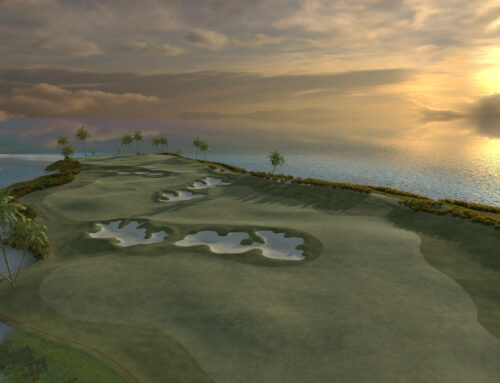Golf Equipment: A Case Study
by
Joe Sponcia
February, 2020
Much like every course in America built before 2000, my home club Holston Hills CC, has been ravaged by golf equipment “advances” for nearly 100 years.
Watching the 2020 edition of the Phoenix open, followed by the Super Bowl offers casual fans a bird’s eye view of just how out of touch the game of Golf is compared with other major sports.
Football has had the same playing field dimensions since the game’s inception: 100 yards long by 53.33 yards wide. Basketball: 94 feet long by 54 feet wide. And Tennis: 78 feet long by 27 feet wide.
The sport of Baseball is probably the closest to Golf, of the major sports in that its outfield lines vary just like that of individual golf courses, however, Babe Ruth or Mickey Mantle in their prime would have been comfortable playing in 2020 since the equipment hasn’t forced individual stadiums to extend the height or length of outfield walls.
Over the weekend, the USGA finally admitted that equipment needs to be reined in, a stance Max Behr, Jack Nicklaus, and Tiger Woods have agreed with for some time.
Just how bad is it?
In 1997, John Daly became the first golfer on the PGA Tour to average more than 300 yards per drive. That year, he was more than 30 yards longer than the average Tour player. Now, 21 years later, the entire PGA Tour averages 295.3 yards off the tee — the longest average ever. By the way that stat has been increasing over the past five years, don’t be surprised to see the Tour’s average break the 300 mark by 2024. In 1980 (the first year that the PGA Tour’s driving distance stats are available), Dan Pohl led the field while averaging 274.3 yards per drive. The Tour average was a meek 256.89 yards.
-Danny Wilco
Since Lebron James doesn’t routinely make 50 foot shots and Tom Brady doesn’t throw the ball 80 yards downfield, the historical records and athletes, for the most part, are on a level playing field with the stars of the past from every major sport. Golf not so much due to the ever-advancing distance gains in equipment and agronomy.
In the 1950 US Open at Merion, Ben Hogan hit arguably one of the greatest shots in golf history using a now-extinct 1 iron. The par 4, 18th was a stout 458 yards at the time. Hogan was reportedly between clubs after his drive left a difficult 213 yards, to the uphill green. One can only wonder what a modern player Hogan’s size would hit into the hole some 50 yards down the fairway? Perhaps a soft 9 iron?
Shot values are an often discussed topic among ardent students of the game. When Alister MacKenzie and Bobby Jones laid out Augusta National in 1933, for instance, they did so with the intention of having certain clubs (or shots) be employed with varying trajectories into greens designed to uphold par, per the equipment of their era.
To cite only one hole at Augusta, it’s doubtful the duo imagined or intended for players to use a short iron for their second shot into the par 5, 13th, one of the greatest holes in golf … but that is where the game finds itself today; resigned to shorter clubs being played into holes designed to receive longer ones or being forced to extend tee boxes to artificially account for unfettered equipment.
When Donald Ross completed Holston Hills CC in 1927, it was one of the longest and toughest in America at 6,618 yards.
Over Christmas break, I stumbled upon several accounts of 1920’s and 30’s golfers hitting very long clubs into holes the modern player would hit wedges into, which in turn made me wonder just how difficult Holston must have been in 1927. Being generous per historical accounts of the time, let’s assume the 1920’s highly-skilled amateur carried his drive 225 yards with 15 additional yards of roll out. Let’s also be generous in the other direction with the 2020 version of a highly-skilled golfer, and assume drives carry 270 yards and roll out to 295 yards.
Hole by hole yardage + commentary:
1927 2020
#1 427 448 240 yard drives leaves 187, which at the time would have left a 4 wood vs. 295 yard drive, leaving 153 yards (9 iron). #1 should be extended to 515 yards to equate to a 3 iron/hybrid approach of 215-220 yards. Addition: 88 yards
#2 402 422 240 yard drives leaves 162 yards (5/6 iron) vs. 295 yard drive, leaving 127 yards (gap wedge). #2 should be extended to 495 yards to equal a 5 iron approach. Addition: 93 yards
#3 359 426 240 yard drive leaves 119 yards (8/9 iron) vs. 295 yard drive, leaving 131 yards (gap wedge). #3 should be extended to 450 yards to equate to a 8/9 iron. Addition: 91 yards
#4 164 165 4/5 iron vs. 8 iron. #4 should be extended to 200 yards. Addition: 36 yards
#5 586 615 240 yard drive leaves 346 yards, 2nd shot 3 wood leaves 126 yards, 3rd shot 8 iron vs. 295 yard drive leaves 320 yards, 2nd shot 3 wood leaves 65 yards, 3rd shot 70% lob wedge. #5 should be extended to 715 yards. Addition: 129 yards
#6 337 355 240 yard drive leaves 97 yards (Pw) vs. 295 yard drive leaves 60 yard lob wedge. To approach with a pitching wedge, #6 would have to be stretched an additional 90 yards to 445 yards. Addition: 108 yards
#7 458 517 240 yard drive leaves 218 (3/4 wood) yards vs. 295 yard drive leaves 222 yards (hybrid). To approach with 3 wood, #7 would need to be stretched to 545 yards. Addition: 87 yards
#8 139 148 6/7 iron approach in 1927. #8 would would need to move back to 190 yards to accomplish the same shot value. Addition: 51 yards.
#9 413 417 240 yard drives leaves 173 yards (4 iron) vs. 295 drive leaves 122 yards today (gap wedge). #9 would need to add 500 yards to equate to a 4 iron today. Addition: 87 yards
Front 9 additional yardage total: 770 yards or 4,085 yards.
1927 2020
#10 392 432 240 drive leaves 152 yards (6/7 iron) vs. 295 drive leaves 137 yards (Pw). #10 would need to extend to 480 yards to replicate the same shot value. Addition: 88 yards
#11 193 200 2/3 iron tee shot vs. 5/6 iron today. #11 would need to move back 20 yards to equate to Ross’ original intent. Addition: 20 yards.
#12 442 471 240 drives leaves 202 yard approach (solid 1 or 2 iron) vs. 295 yard leaves 176 yards (7 iron). New yardage would need to extend to 530 yards. Addition: 88 yards
#13 433 456 240 yard drives leaves 193 yards (2/3 iron) vs. 295 yard drive leaving 161 yards (8 iron). #13 should be extended to 515 yards. Addition: 82 yards
#14 175 212 4 iron vs. 4 iron today. The only hole that has been modernized to 1927 shot values. No change.
#15 380 421 240 yard drive leaves 140 yards (6/7 iron) vs. 295 yard drives leaves 126 yard (gap). Hole would need to move to approximately 465 yards. Addition: 85 yards
#16 306 304 240 drive leaves 66 yards (SW), today most players hit hybrid or soft 3 wood, then lob wedge. #16 should move to 361 yards. Addition: 55 yards
#17 491 520 240 drive leaves 251 yards, unreachable in two shots vs. today at 520 yards, the hole is reachable in two shots with hybrid to 5 iron for the better player being downhill. Hole would need to extend to 580 yards. Addition: 89 yards
#18 448 541 240 drive leaves 208 yards to the uphill green which would have been a 3-4 wood. A 295 yard drive today leaves 246 yards by pure math, but the modern player can get 35-40 yards extra roll due to carrying the crest of the hill, leaving a 4-5 iron approach for the 2nd shot. Note, this is with the hole already extended nearly 100 yards from the original Ross yardage. To equate to 1927 shot values, the hole should be extended to 570 yards. Addition: 122 yards
Back 9 additional yardage total: 629 yards or 3,937 yards. New course yardage total: 8,022 yards. This equates to an approximate 20% increase.
In Basketball terms, the rim would need to move up to 12 feet. Football fields would need to extend to 120 yards vs. the current 100 yards. Baseball parks with 500 foot walls would need to add another 100 feet to ensure the modern player was on a level playing field with Babe Ruth or Mickey Mantle.
Plainly, Golf equipment companies and its Governing bodies have been implicit in adding increased costs to the game via:
- More cart paths
- More water
- More fertilizer
- More man hours
- More tee boxes
- More real estate
- Slower pace of play
Iconic long irons from the likes of Jones, Hogan, Nelson, Snead, Nicklaus, Palmer, and Norman have been reduced to boring 8 irons and wedges. Go-for-broke 3 wood approaches have turned into towering 4-5 irons that stop on a dime.

Ben Hogan yardage chart (Power Golf)

Jack Nicklaus yardage chart (Golf My Way)

Greg Norman yardage chart (shark.com)
Has the game become more interesting? Should the public consider 8,000 yard courses the mark of a Championship course?
Clearly, when a desk-job working author at 5’6”, 175 lbs and a few days away from turning 48 years old can hit two less clubs than Greg Norman in his prime, something needs to change.
It is nonsensical to continue disfiguring the great works of Donald Ross, Alister MacKenzie, A.W. Tillinghast and Seth Raynor over something so easily remedied. The time to act is now.









